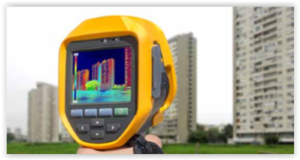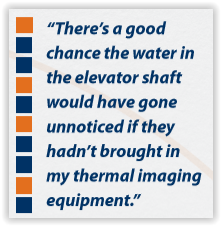A Tale of Two Buildings
LET’S TALK ABOUT THERMAL IMAGING
 Today, I’m going to tell you about two projects I worked on this past summer that involved the tricky business of water.
Today, I’m going to tell you about two projects I worked on this past summer that involved the tricky business of water.
The first project was in a high-rise apartment complex in Houston. A tenant on the eighth floor had a bad water leak which spread throughout the building. This was a disaster, and the building owner wasted no time getting on the phone with the water restoration company. In addition to getting the mess cleaned up, the building owner also requested thermal imaging be conducted.
That’s where I came in. The water restoration company hired me to come out with my thermal imaging equipment and walk around the building. This technology lets us pinpoint exactly where the water is within the walls. The leak from the eighth floor had also saturated half the seventh floor, part of the sixth floor, and a good portion of the remaining floors all the way down to ground level. Thermal imaging also showed that water had reached the elevator shaft. It was a good thing we made this discovery early on, because the water could have easily moved out of the shaft to other unaffected portions of the building.
There’s a good chance the water in the elevator shaft would have gone unnoticed if they hadn’t brought in my thermal imaging equipment. It’s not like the water restoration guys could have put someone in a harness and dangled them down the shaft with a moisture meter in hand, looking for water!
 Due to the tricky way water behaves, it’s not uncommon for moisture to end up in unexpected places. The owner of this apartment complex was well aware of this and had me come back a few days later to check for moisture again. Sure enough, while most of the water had dried, thermal imaging found moisture in new places it hadn’t yet reached during the first scans. (Someone I respect highly in my industry says, “Water is insidious! It goes down … unless it goes sideways or up!”)
Due to the tricky way water behaves, it’s not uncommon for moisture to end up in unexpected places. The owner of this apartment complex was well aware of this and had me come back a few days later to check for moisture again. Sure enough, while most of the water had dried, thermal imaging found moisture in new places it hadn’t yet reached during the first scans. (Someone I respect highly in my industry says, “Water is insidious! It goes down … unless it goes sideways or up!”)
Around the same time, a commercial building, 28-stories high, was having the same sort of problem. A large leak sprung on the 16th floor, but no one caught it for several hours, and it ended up causing an enormous problem. This time, though the building owner didn’t request thermal imaging. I was called out there by the water restoration company to help determine the magnitude of the situation. We worked our way down, floor by floor, and found there was heavy water damage all the way to the basement.
In my experience, when it comes to water restoration, thermal imaging is nonnegotiable. If you aren’t calling me to help take care of the problem, then at the very least, you should insist that the guys you do call use thermal imaging to find all the moisture and get an accurate picture of the problem. With the way water moves, this technology is the only way to really track it.
Thermal imaging is a huge resource for building owners and insurance companies when dealing with water damage. If any moisture gets missed and mold ends up growing on the sheetrock down the road, it’s the building owner who will be held responsible.

